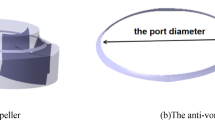Abstract
The aeroacoustic characteristics of a centrifugal fan for a vacuum cleaner and its noise reduction method are studied in this paper. The major noise source of a vacuum cleaner is the centrifugal fan. The impeller of the fan rotates at over 3000 rpm, and generates very high-level noise. It was revealed that the dominant noise source is the aerodynamic interaction between the rotating impeller and stationary diffuser. The directivity of acoustic pressure showed that most of the noise propagates backward direction of the fan-motor assembly. In order to reduce the high tonal sound generated from the aerodynamic interaction, unevenly pitched impeller and diffuser, and tapered impeller designs were proposed and experiments were performed. Uneven pitch design of the impeller changes the sound quality while the overall sound power level (SPL) and the performance remains similar. The effect of the tapered design of impeller was evaluated. The trailing edge of the tapered fan is inclined. This reduces the flow interaction between the rotating impeller and the stationary diffuser because of some phase shifts. The static efficiency of the new impeller design is slightly lower than the previous design. However, the overall SPL is reduced by about 4 dB(A). The SPL of the fundamental blade passing frequency (BPF) is reduced by about 6 dB(A) and the 2nd BPF is reduced about 20 dB(A). The vacuum cleaner with the tapered impeller design produces lower noise level than the previous one, and the strong tonal sound was dramatically reduced.
Similar content being viewed by others
References
Frank P. Bleier, 1998,Fan Handbook, Selection, Application and Design, McGraw-Hill., Chapter 19.
Kazuyuki Sugimura, Masatoshi Watanabe, 2000, “A study on suppressing acoustic resonance of interaction tones from a centrifugal motor fan,” Proceedings of Seventh international congress on sound and vibration, pp. 1259–1266.
Lauchle, G. and Brungart, T., 2000, “Modifications of a vacuum cleaner for noise control,” The 29th international congress on noise control engineering.
Neise, W., 1976, “Noise Reduction in Centrifugal Fans: A Literature Survey,”Journal of Sound and Vibration, Vol. 45, pp. 375–403.
Neise, W., 1982, “Review of Noise Reduction Methods for Centrifugal Fans,”Journal of Engineering for Industry, Vol. 104, pp. 151–161.
Takuro Hayashi, Yoichiro Kobayashi, Akira Nagamori and Hirofumi Horino, 1996, “Low Noise Design of Cross-Flow fan Based on Frequency Modulation,”Transactions of the JSME (C), Vol. 62, pp. 68–72.
Toru Hirose, 1989, “Status Quo of Electric Appliance Noise Problems and Countermeasures,”National Technical Report, Vol. 35, No. 5, pp. 83–90.
Wan-Ho Jeon, Seung-Jo Baek and Chang-Joon Kim, 2003, “Analysis of the aeroacoustic characteristics of the centrifugal fan in a vacuum clenaer,”Journal Sound and Vibration, Vol. 268, pp. 1025–1035.
Author information
Authors and Affiliations
Corresponding author
Rights and permissions
About this article
Cite this article
Jeon, WH., Rew, H.S. & Kim, CJ. Aeroacoustic characteristics and noise reduction of a centrifugal fan for a vacuum cleaner. KSME International Journal 18, 185–192 (2004). https://doi.org/10.1007/BF03184727
Received:
Revised:
Issue Date:
DOI: https://doi.org/10.1007/BF03184727



